#bill strutton
Text

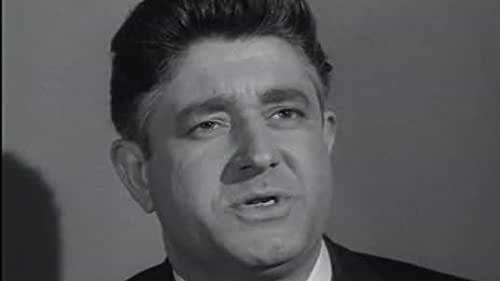
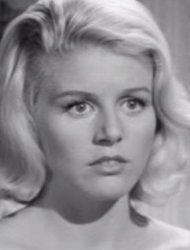


The Saint: Iris (2.8, ITC, 1963)
"I'll take you to the bank. We'll get a list of the serial numbers."
"Inspector, may I make a suggestion?"
"No."
"Ask a silly question..."
#the saint#iris#itc#leslie charteris#bill strutton#john gilling#roger moore#barbara murray#david bauer#ivor dean#cyril luckham#ferdy mayne#john ronane#tony wager#barry linehan#meadows white#april wilding#larry taylor#margaret nolan#he is here! Ivor Dean finally arrives as the permanent Inspector Claud Eustace Teal (although funnily enough he goes unnamed in this debut#episode; he is definitely Teal tho‚ per the end credits). Dean is immediately Teal‚ idk i just feel like he gets the part immediately; his#absolute disdain for Templar‚ the long suffering hangdog face‚ the refusal to even entertain the idea of humouring or empathising with the#civilians brought into the case.. oh his Teal may not be entirely book accurate‚ but he fully embodies this tv character as much as Moore#does Templar. this week's case concerns both a protection racket and blackmail‚ with a background of 60s theatre; Simon is very snobby#about the (fictional) play‚ as is p much everyone else (i thought it sounded interesting!). Bauer returns for hia third guest star stint#and baby John Ronane gets a couple of scenes‚ but of course the big attraction here is Barbara Murray. The Plane Makers was just beginning#its second series around this time (the series where Barbara joined the cast) but Babs was a genuine film star in her youth(er) so would be#well known to 60s audiences. she's wonderful of course (need it be said) and brings her usual louche charm and array of interesting hats to#the role. ironically‚ of the cast‚ it's probably Barry Linehan (here playing a gangland thug as he so often did on tv) who had the most#experience of the kind of budget experimental theatre the 'actors' in the episode are involved in
6 notes
·
View notes
Text
3/ Peter Lumberg: The Essence of the Dear Departed
New Post has been published on https://qnews.com.au/3-peter-lumberg-the-essence-of-the-dear-departed/
3/ Peter Lumberg: The Essence of the Dear Departed

Cairns struggled to dispose of its dead. The essence of the dear departed lingered. None more so than that of Peter Lumberg. Despite an obvious culprit, his murder remains unsolved until this day. Rather than expose corruption in the ranks, the commissioner chose not to pursue the investigation into Peter’s death. All part of the greatest gay scandal in Queensland history.
The motive for the terrible deed and the identity of the murderer is shrouded in mystery, but it is to be sincerely hoped that whoever he may be, he will be brought to book and made to suffer for the dastardly crime of murdering an old and inoffensive man.
Morning Post
News buzzed along the footpaths of Cairns faster than James O’Shea’s cab. Chinese whispers leapt from one rumourmonger to the next. Gossips tossed tittle-tattle over back fences, shop assistants dispensed dirty laundry along with change, and drunks argued hearsay in public bars.
On Tuesday morning, as he rode into town, Arthur Keeble noticed George Dunwoodie guarding a dead body. Stopping only long enough to ask the deceased’s identity, he galloped off to the police station. As the alderman tied his horse to the station fence in Abbott Street, former mayor A J Draper strolled by, and Keeble alerted him to the murder. By the time the alderman reported what he’d seen to Detective Constable Seymour, Draper had told someone, who told someone else, who told someone else again. The news took wing.
Minutes later, Percy Le Vaux ambled from his Abbott Street office to a nearby pub for a morning heart starter. But he never had that drink. Tom Strutton waved him down with news. Keeble told Draper who told Strutton who now told Le Vaux, that there was an elderly man dead at Sandy Gallop. “It might be Peter.”
“I hardly think so,” said Le Vaux, “He was in good health on Sunday.”
But Strutton lived near Mrs Dunwoodie’s Royal Hotel, and Draper mentioned a clearing with a mango tree. That sounded like Peter’s campsite. Le Vaux hoofed it for Sandy Gallop.
Then, as Alfred Chisholm strolled along the same street in search of stories for the afternoon paper, Bill Furmedge called out. “Where is Le Vaux? Keeble brought in the news that Peter Lumberg is murdered.”
Chisholm looked for a cab to take him to Peter’s camp. Detective Constable Seymour was already on the way.
Blanche Le Vaux heard from her back neighbour. Young shop assistant Lydia Male hurried home at lunchtime to tell her mum the shocking news. “Peter Lumberg is murdered.”
“I wonder if Mrs Le Vaux knows,” her mother responded. Jane Male went to the fence and called over to Blanche Le Vaux, “Did you hear anything?”
“No.”
“Lydia just told me Peter is murdered.”
“Oh, my God!”
Jane Male later remarked on Blanche Le Vaux’s lack of emotion. “I was crying, but Mrs Le Vaux did not appear much upset. Previous to his death, she often told me that she did not like Peter.”
Indeed, Blanche Le Vaux made no secret of disliking Peter Lumberg.
“I have known Lumberg since I was a child. About 3 years ago, I renewed his acquaintance in Cairns. He came to my house with Mr Le Vaux for meals. I expressed the hope he would not always be at the house on account of his dirty habits. I often asked Mr Le Vaux to tell Peter Lumberg to go, but he told me to do so myself.”
Despite Blanche’s objection, Peter lived in a shed in her backyard from January 1905 until a few days before his death.
Born Niels Peter Lundberg, the Swede abandoned his homeland in his late teens. He told Jane Male his family treated him unkindly. Peter joined hundreds of thousands of young men lured to Australia by gold. They chased the precious metal from one rush to the next. A lucky few struck it rich. Most barely scraped by. But gold fever is a contagion beyond remedy. Young prospectors lived rough. They grew old in one makeshift bushcamp after another, forever sustained by the dream of sudden instant wealth.
Peter followed the gold from New South Wales to Gympie in South East Queensland and finally north to the Palmer River rush of 1873. Almost a hundred years since the British arrived uninvited in Botany Bay, Cape York remained largely untouched by colonisation. Although the northern wilderness teemed with resources, it was too hot, too distant, and too fraught with danger.
But men will travel to the gates of hell for gold. After a promising discovery in a remote northern river that was promptly named for Premier Arthur Palmer, hundreds of men travelled overland to the new Eldorado. En route, they traversed 70 miles of rocky ground, which later proved impassable for bullock drays laden with supplies. The prospectors faced starvation. And things were about to get worse. The rivers would rise during the upcoming wet season and completely shut off access.
Nevertheless, hundreds of men refused to abandon the field. Premier Palmer feared he’d wear the blame for mass casualties. The government hired a steamship to convey men and equipment to the Endeavour River, where they would establish a base and attempt to forge a track inland.
Scores of prospectors joined the voyage, Peter Lumberg among them. They arrived at the Endeavour River on October 25, 1873, and disembarked at the spot where James Cook and his crew lived for seven weeks in 1770 while they repaired their damaged ship. The newcomers paid tribute to the fabled explorer in the name of the canvas township hastily erected on the riverbank, Cook’s Town.
A few days later, a large company of mounted police and miners struck out in the direction of the Palmer River.
“The command left the Endeavour some 108 strong, about 90 of these on foot with swags from 70-pounds to 90-pounds weight — the supposed distance being about 85 miles, we thought we should not overload ourselves.
“After the first day out, we found we had overloaded ourselves, and many a poor fellow had to throw away his clothing in order to keep his flour. In fact, the road was soon lined with clothing, blankets, tents, and flour.
“The road, instead of 85 or 90 miles, turned out to be 160, and most say it is fully 180. Anyhow, it is a hard road to travel.
“We had three brushes with the blacks. Twice they attacked us, and once, the black troopers [native police] had a skirmish with them; but wherever the troopers came across them, they made short work of them. They are a good-looking race of blacks — fine, tall and well-made, many over six feet in height, and a pure copper colour. Miners going this route should not go in less than parties of eight and then well armed with guns or rifles. Revolvers are no use, as the blacks can kill with their spears from 80 yards. They always attack at the break of day, but a good watch must be kept all night. Their war-whoop is the cry of the black cockatoo.”
Charles Jackson made the journey a couple of months later. He wrote to a friend in Sydney that he only lasted three weeks on the field due to the lack of food.
“The day we started to come down, we had to swim the Palmer River. One of my mates drowned trying to do so. But we either swam the river or died of starvation. I undressed and made a swag of my clothes, money, and everything else I owned. About halfway, the current compelled me to let my swag go, and I was carried about one hundred yards before I could land on the other side. I and my mate were left with nothing. I walked 150 miles naked as I was born.”
A former night watchman from New South Wales named Richards wrote home to his family in Gulgong.
“Everyone can get a bit of gold, but not enough to pay the cost of living. Many are starved; you could almost read the Gulgong Argus through them. I walked back from the Palmer in five days. For the last three, I had nothing to eat and no boots to protect my feet. My clothing consisted of a shirt and hat. My skin was tanned to a chestnut colour. I saw many others naked on the road with only hats to protect their heads.”
Peter soon gave up on full-time prospecting and partnered with another former miner carting supplies between the coast and the goldfields. He became friends with shopkeeper Louis Severin, Blanche Le Vaux’s father, one-time mayor of Cooktown and later three-time Mayor of Cairns.
But Cooktown, as it was soon known, enjoyed only a brief heyday and then a slow decline as more convenient routes opened to the hinterland. Louis Severin packed up his business and family and moved to Cairns, the new boom town. Blanche Severin did not see Peter Lumberg again until after her 1902 wedding to Percy Le Vaux. She never understood her husband’s devotion to the old bushie. Following Peter’s murder, others also questioned the relationship. Some voiced suspicion earlier. In 1904, the Morning Post censured Le Vaux for associating with his social inferiors.
“He takes the wharfie to his bosom, and is not above a filial alliance with some old, drunken reprobate.”
Ouch! Carefully constructed sexual innuendo. A denunciation of rough trade and a touch of ‘Who’s ya daddy?’ (Peter Lumberg was a renowned drunk at the time.) Of course, in years to come, foolish people would deny people of the era ever discussed such things. ‘Oh no. It was a more innocent time, and they meant something totally innocuous.’ Bullshit! Consider a 1903 Morning Post report on council discussions about the difficulty in proving the occupations of women working in suspected brothels. “The occupiers of these places all describe themselves as dressmakers,” said Mayor Severin.
“Trouser hands, I suppose,” interjected Alderman Brown.
Alderman Bulcok proposed a solution. “Alderman McLachlan is a single man, and I move that he sacrifice himself on the altar for the sake of his country.” Yep. Take one for the team. Humour never changed so much after all.
Sub-Inspector Patrick Bowen heard about the murder at Cairns railway station when he arrived back from Mareeba at 6 pm Tuesday night. As he headed for Sandy Gallop, Acting Sergeant McGuire and Constable Murray pulled up in James O’Shea’s cab and reported on the day’s events. Bowen went and checked out the crime scene himself. Wednesday morning, he sent his available officers and black trackers to search the campsites around Sandy Gallop for weapons and bloodied clothing. He said he went to ‘a great deal of trouble’ to investigate the theory that a black man killed Peter Lumberg. Not because of evidence but because of the papers. The Morning Post wasn’t too bad, although the paper’s reporter arrived late at the crime scene and compiled his report from second-hand accounts and conjecture.
“From the appearance of the sandy soil where the body lay, it was apparent that old Peter Lumberg had not succumbed to the assassin without a struggle. The ground was torn up and bushes broken down as if the deceased fought inch by inch for his life before being stabbed to the heart.”
Wrong! Wrong! And wrong again! Those who examined the crime scene observed few signs of struggle, and only a solitary bush suffered damage. Dr O’Brien detected just one tiny cut on the third finger of Peter’s right hand, indicating he offered little resistance.
But although incorrect, the Morning Post article would not cause the police trouble. That would arise from the Cairns Argus article in which Chisholm — who knew better — repeated the ‘desperate struggle’ nonsense.
“From the appearance of the ground, it is evident that a desperate struggle took place before he was killed.”
But worse still, the Argus and papers across Australia repeated as gospel the misinformation provided to them by Alfred Chisholm.
“It is believed the crime was committed by Kanakas.”
Believed by who? One person — Alfred Chisholm. Even Le Vaux moved on to blaming Aboriginals after briefly attributing the murder to Kanakas and then Malays. But in 1905, as White Australia prepared for mass deportations of South Sea Islanders, politicians, unionists and anti-black-labour newspapers relentlessly demonised Kanakas as murderous thugs. Once the narrative of a Kanaka killer took hold, the public was unlikely to accept the arrest of anyone else. Bowen would need to prove that someone else committed the crime and also that a Kanaka did not. So, before beginning an investigation into who killed Peter Lumberg, he set out to prove who did not.
At 11 am, the Sub-Inspector joined Peter Lumberg’s funeral procession from Cairns Hospital to the local cemetery. Town elders chose the McLeod Street site after the tide exposed coffins buried in the original graveyard on the beach. However, they did not select the new location for its suitability as a burial ground. They chose it because it was unsuitable for future residential or commercial use. It was on the edge of the swamp. The underground water table rose to within a few feet of the surface. Funeral parties sometimes waited for gravediggers to excavate a fresh plot after mourners watched water fill the original during the ceremony. Undertakers learned to weigh coffins down to stop them from re-emerging from the sand.
After an official report into the health hazard posed by decaying cadavers, aldermen advised nearby residents not to drink water from their underground wells. Otherwise, they risked sipping the essence of the dear departed in their morning cuppa.
The Sub-Inspector made discreet inquiries among the mourners. But all anyone wanted to discuss was the victim’s relationship with his lawyer. On Tuesday afternoon, some town ladies felt an uncustomary urge to visit friends in the neighbourhood of Peter’s camp. Sandy Gallop was the other side of the tracks — the wrong side of the tracks. People hoping to host the upper crust for afternoon tea did not build houses there.
“The salubrity of the locality is evidently not conducive to harmony in neighbourly relationships,” intoned the Morning Post.
The paper probably had in mind incidents like when Tom Strutton’s wife punched a neighbour, pulled her hair and attempted to choke her. In Biddy Strutton’s defence, Betty Johnson did call her a ‘dirty Irish bitch’, a ‘damned slut’ and other disgraceful epithets the Morning Post considered unfit for publication.
But a murder. That changed everything. Jane Male and other townsfolk flocked to visit Biddy Strutton, the widow Collinson, and other residents of the area. At the funeral the following day, they shared the story of Fanny McDaniel’s scandalous denunciation of Le Vaux as the murderer.
Otto Linderman divulged another intriguing anecdote. Busy working on Tuesday afternoon, he never heard about the murder of his friend of 27 years. But that night, he encountered a wasted Marston Mayers at the Federal Hotel. According to Percy Le Vaux, he and Mayers dropped by Peter’s camp late Monday night, making them the last known visitors to the crime scene before the discovery of the body. Otto learned about his old mate’s death when Mayers suddenly blurted, “We are supposed to have killed Peter Lumberg.”
Sub-Inspector Bowen learned much about the murder victim from businessmen who had dealings with him in the months before his death. Looks, they say, can be deceiving. That was certainly true of Peter Lumberg. The grubby old prospector, ‘the missing link’, he of the stained, ragged clothes and matted hair, and according to Blanche Le Vaux, dirty habits, was a wealthy man. Yes, he lived in sheds or bush camps, but the old prospector owned five houses in town, including the one rented by Percy Le Vaux. According to rumour, Le Vaux recently drew up a will for Peter, with himself as executor and Mrs Blanche Le Vaux as beneficiary.
Bowen’s search parties failed to turn up any new evidence during the morning. No weapons. No bloodied clothing. Or leads. Additionally, people who lived near Peter’s camp unanimously agreed they’d seen no ‘coloured people’ hanging about. Crucially, Bowen noted there were no barefoot tracks at the crime scene. That was important. Kanakas and Aboriginals rarely wore footwear. George Dunwoodie insisted he saw no barefoot tracks at the crime scene. Also, Bowen had expressly checked for barefoot tracks himself on Tuesday afternoon.
He later said that despite going to ‘a great deal of trouble’, he found no evidence to indicate a black killer. “I had a Kanaka, up to ten police and four Aboriginal trackers making inquiries and searching the camps. I could find no clue that the murder had been committed by a coloured man.” Bowen pulled Detective Constable Seymour off the search and instructed him to find out what he could about Percy Le Vaux, ‘an intimate friend of the deceased, and continually in his company’.
Thursday was Show Day. Employers gifted their workers a half day off, and most of the town headed for the Show Grounds at the Four-mile on Mulgrave Road near William Cannon’s farm. Percy Le Vaux hired a cab for the occasion. Before leaving for the Four-mile with Chissy, he popped into the police station to check on the investigation’s progress. After the freshly crowned ‘person of interest’ left, Bowen decided to search his home and office. He called out to Detective Constable Seymour. “Le Vaux has just driven away to the Show Grounds; get your horse and bring him back, and I will get a search warrant.”
Seymour caught up with the cab just over the railway lines, and Le Vaux reluctantly agreed to return.
“As Lumberg has been staying at your house,” Bowen told him, “I would like to search your premises for anything in connection with the murder.
“It will cause suspicion,” responded Le Vaux.
“We will do it as quietly as we can. It is a holiday, and there are few people about.”
The lawyer tried one last dodge. “It will spoil my half-holiday.”
At Le Vaux’s house, the police found another bloodied tomahawk and, at his office, an undated will.
Hubert Durham, gay policeman and the great police cover-up:
The gay scandal QLD Police hushed up for over a century.
1/ The murder
2/ Sandy Gallop
3/ The Essence of the Dear Departed
For the latest LGBTIQA+ Sister Girl and Brother Boy news, entertainment, community stories in Australia, visit qnews.com.au. Check out our latest magazines or find us on Facebook, Twitter, Instagram and YouTube.
0 notes
Text
The Warrior Before Time
The Warrior Before Time
Roger Moore starred in five different series in the early, pre-Bond years of his career (good on you if you can name them all without a reference). The first of these was ‘Ivanhoe’ from 1958-59. A one-and-done show set of 39 (!) half-hours that got Moore started. While the show was a co-production with an American company, the show, as it should have been, was British through and through, and that extended to the army of character actors, many also just starting their careers, which populated shows of that era.
In episode 35 of 39, ‘The Swindler,’ Jon Pertwee pops up as Peter the Peddler, the titular swindler. And he’s in fine form here as a fast-talking agent of chaos, conning Robert Brown’s character out of money, which sets Ivanhoe against him, but it turns out Ivanhoe can use his skills to outwit another nobleman who is also against Ivanhoe. Got all that?
Like most half-hours of this time, Ivanhoe is proto-TV which is evolving before your very eyes, but is also contrained by format in terms of character development and plotting. Still it’s a fun ride, and Pertwee is a delight in a glimpse of his earlier roles.
In Doctor Who terms one can’t help but think of The Time Warrior in terms of being a (pseudo) historical look at dress and attitude. Of course the time periods don’t match, but you won’t bedrudge an easy, if strained comparison, will you? Also the ‘Ivanhoe’ episode was written by Bill Strutton, who also had a Doctor Who connection. He wrote The Web Planet.
See how it all ties together? Never mind.
Tags and categories: Tangential Tardis, Jon Pertwee, The Web Planet, The Tiime Warrior
via WordPress https://ift.tt/zmsUj6f
May 19, 2023 at 08:00AM
0 notes
Text
“Invasion”
Season 2, episode 20 - 13th March 1965

[id: The Doctor leans against a wall, and Vicki sits on the floor next to him. Vicki is stroking the nose of a Zarbi, and says “He’s quite cute, isn’t he, when he’s like this?” /end id]
I don’t know how much Dr Who’s ring factors into the other episodes in the early years, but I do find it amusing that even before the sonic screwdriver was introduced the writers decided that having a magic plot-resolving device that Dr Who already has with them to use out of nowhere when it becomes necessary for the narrative was a good thing for the show.
Fun: 2/5
Production: 2/5, action scenes are so funny in this story as the actors try very hard not to actually damage the intricate costumes and props but also need to slap a giant bug against a wall.
Pacing: 4/5
Character Writing & Use: 3/5, Barbara and Dr Who & Vicki’s plots converging is great, but Ian is still very much stuck underneath the planet doing absolutely nothing for an entire episode. I don’t think this is a case of William Russel being unavailable for filming with the others, because he’s in the episodes fairly consistently and we’ve already had Barbara missing entirely without much comment. This seems more like Bill Strutton really wanted to use the idea of the apparently regressed Menoptra living underneath the surface of the planet, and decided to shoehorn the idea in and not integrate it with the main plot at all.
Depth: 3/5
Not Ageing Horribly: 3/5, I still think that the underground Menoptra being so superstitious is weird, but the issue is more playing into generic stereotypes rather than anything more specifically targeted, especially since their existence as some sort of diverging evolution lost to time is a really weird way to do things. But drawing a line between the two types of Menoptra is odd, although they do then make sure they point out that the line barely exists in the conclusion of next episode. So maybe this is all nothing.
Overall Score - 17/30
1 note
·
View note
Text
Doctor Who (1963-1989; 1996; 2005-)

THE FIRST DOCTOR
Season TWO (1964-65)
——————————————————————————
Cast:
William Hartnell as The First Doctor
Carole Ann Ford as Susan Foreman (until The Dalek Invasion of Earth)
William Russell as Ian Chesterton (until The Chase)
Jacqueline Hill as Barbara Wright (until The Chase)
Maureen O'Brien as Vicki (from The Rescue)
Peter Purves as Stephen Taylor (from The Chase)
——————————————————————————
1. Planet of Giants by Louis Marks (3 episodes)
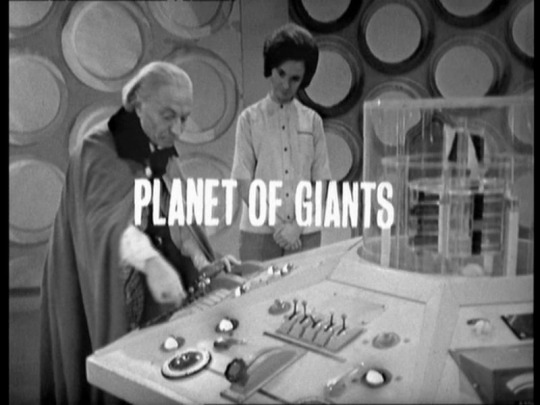
Planet of Giants is one of those stories that is neither bad nor particularly great either. The concept isn't anything new to us for today's standards but back in 1964 this was a bold concept that required a lot of creativity to work. To its credit, Planet of Giants works its concept rather well visually and Louis Marks has enough going on in the story to keep things from getting dull. The story is rather compact at just 3 episodes and while there is no character work in the script at all, it is rather good fun all round if not essential.
3/5
2. The Dalek Invasion of Earth by Terry Nation (6 episodes)

This long awaited sequel is a classic science fiction alien invasion story that features some iconic imagery and does well to depict a dystopian and war torn London under occupation by the Daleks. The story has some surprisingly dark concepts and plenty of set pieces with a high body count for 1960's Doctor Who even if the voices of the Robomen and visual effects quality of the spaceships are a bit dodgy. I think it makes better use of its episode count than the first Dalek serial and this also deploys the Daleks more effectively in a more action packed serial than their debut. This is also the beginning of the end of the first era of Doctor Who with the sad departure of Susan making it a major point in Doctor Who history. This also features perhaps William Hartnell's most memorable moment as the Doctor. With some compelling support characters, a general and continuous sense of peril; this is a superior sequel to season one's The Daleks.
4.5/5
3. The Rescue by David Whitaker (2 episodes)

Much like the Edge of Destruction, the Rescue is a two part story that serves a specific purpose which in this case is to introduce the newest companion; Vicki. The story itself is a rather straightforward one with just a small collection of characters against a single threat. The ending isn't too difficult to see coming and it gives William Hartnell something more physical to do. Maureen O'Brien effortlessly joins in with the main cast even if she is perhaps playing a character a little too similar to Susan. It's no classic but certainly serves its purpose.
3/5
4. The Romans by Dennis Spooner (4 episodes)

This is a historical serial that starts off quite slow and rather dark before shifting into a more comedic tone. This wasn't a particularly well received story in 1965 in part of its tonal shift and to be honest I can understand why; it's by no means as rich as The Aztecs and the comedy undermines the educational credentials that this era of Doctor Who was envisioned. However I feel this is a story that only really comes to life for me once the more comedic elements are introduced with Derek Francis' panto take on Nero being perhaps the biggest highlight. William Russell is stuck doing his usual thing as Ian and Maureen O'Brien enjoys great chemistry with William Hartnell's Doctor even if she isn't given much to do. Not the best by any means but certainly not among the worst either.
2.5/5
5. The Web Planet by Bill Strutton (6 episodes)

When watching classic era Doctor Who, you need to be able to look past the cheap looking alien designs and limited special effects of the time to get the most of out it. Unfortunately The Web Planet is severely compromised by the effects of its time and has aged to such an extent that credibility is compromised for modern viewers. The Zarbi don't convince in the slightest and the story barely has any excitement to it. The ambition is unquestionably there, the design of the planet Vortix works very well as does Hartnell and O'Brien's performances. Sadly this is a serial that time hasn't been kind to.
1.5/5
6. The Crusade by David Whitaker (4 episodes)
This serial is missing
7. The Space Museum by Glyn Jones (4 episodes)

8. The Chase by Terry Nation (6 episodes)

9. The Time Meddler by Dennis Spooner (4 episodes)

#doctor who#dr who#bbc#bbc television#classic doctor who#black and white#science fiction#sci fi#the doctor#the first doctor#william hartnell#susan foreman#carole ann ford#ian chesterton#william russell#barbara wright#jacqueline hill#second season#1960s television#maureen o'brien#peter purves#vicki#stephen taylor
9 notes
·
View notes
Text
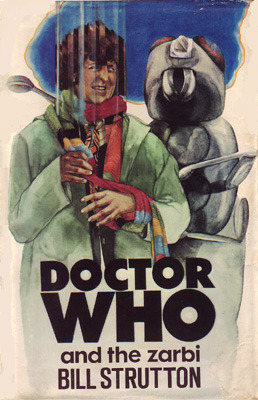
Doctor Who And The Zarbi, only the second Doctor Who novelisation published, for which Bill Strutton adapted his own script to The Web Planet. First published by Frederick Muller Ltd. in 1965, the rights were later acquired by Target Books who reissued the novel in 1973 as the second in their long running series of DW novelisations. This edition, published by White Lion in 1975, features Tom Baker, then the Doctor, on the cover - despite retaining the original illustrations of William Hartnell within.
#doctor who#doctor who and the zarbi#the web planet#bill strutton#1965#frederick muller ltd.#target books#white lion#1975#tom baker#tv tie in#thebookofthefilm
13 notes
·
View notes
Text
every target novelisation....2!
planet of giants by terrance dicks
ok so i think that the reason that this is...good, and an unearthly child was...not good, is because this was written 9 years later when like. other, non-terrance dicks people were also novelising stories and he wasn’t just grinding them out on an industrial level. planet of giants isn’t one of the greats of doctor who but this is a competent adaptation - it doesn’t add much but it does flesh out what’s already there, giving us some backstory elements and making the appearance of giant insects and bodies seem a bit more dramatic than they could manage in 1964. unfortunately it also alters my favourite line from the story (‘i don't know how you know, you're supposed to know!’) and the doctor is weirdly hostile at the beginning (he’s looking forward to ditching ian and barbara, he responds to barbara’s observation ‘drily’ like he’s being a bit sarcastic over her, um, *checks notes* noticing important details). also, dicks describes this in the opening as ‘the doctor’s most grotesque and terrifying adventure’ and i’m like...planet of giants? really??
doctor who and the dalek invasion of earth by terrance dicks
ok this one legitimately doesn’t change much at all. it cuts down on some things (including the doctor’s end speech being shorter - i’m assuming that’s a space thing), fleshes out on pov bits as you can in prose, gets rid of the smacked bottom line. bizarrely there are a few times that susan calls her grandfather the doctor which...i’m pretty sure wasn’t there originally. aside from all those small details, yeah it’s basically the same, but it’s well adapted for prose (i genuinely think it stands as a novel in its own right), and depending on your reading speed it might actually be a nice, shorter alternative to the television version - it was around 45 minutes less time for me. some general things i wanted to comment on: the resistance is explicitly shown as kinda gender segregated (exclusively women are preparing food when we first see it) which irritated me; the description of parliament as a symbol of ‘human progress and tradition’ reminded me of blood harvest having the lords/commons system as the Ideal Form Of Government, in terms of how terrance dicks thinks (this may only interest me? idk i very probably spend too much time thinking about the political views of this particular dead dr who script editor); there’s a use of holocaust here that’s technically accurate to what the word literally means but it felt weird to me to use it.
the rescue by ian marter
oh man i’ve been busy and this took me aages to read. it kinda...diverges increasingly from the original story as it goes on. we’ve got some scenes with the seeker crew (incidentally one of them says ‘ass’ and i was like???hello???you’re allowed to do that in a dr who book from 1987???), and then most of the expanded stuff is in the climax. dr who and bennett have a full on brawl! ian, barbara and vicki visit a destroyed didoi city on their way back to the tardis! mysterious silver figures! a giant worm encounter! incidentally, this does have way more of a downer ending than the original because it’s strongly implied that the last two of the didoi were killed by seeker crewmembers who fired in a panic, after which the report that forms the epilogue ends with “goodwill to all persons” to give us a taste of bitter irony. so that’s kinda grim. um...there’s actually a lot of little changes and minor expansions to this one as well so off the top of my head: we learn more about why vicki left earth (global warming :/), sandy is a lot more threatening-looking than on screen, the crashed ship gets its name changed to astra-nine, ian and barbara hold hands briefly, barbara’s fall really leaves her beaten up. i like the seeker crew comparing the tardis briefly passing them to various non-police box objects from the future (although the link to china is a bit eastern world=alien association for my tastes), dr who telling vicki ‘give that pretty face a wipe’ is clearly him attempting to cheer her up and it’s not meant to be weird but i found it weird. finally, i’ve gotta say i appreciate ian marter’s commitment to ‘mildly unsettling’ in his descriptions of tardis materialisations. this was the last novelisation he wrote before his death (the book’s dedicated to him) and mild criticisms aside, i do think he’s a good writer and he brings an interestingly different angle to the series.
the romans by donald cotton
oh my god. how do i even start this. i’m not even going to try cataloguing all the changes because this isn’t even close to a straight adaptation. it’s told in the form of various documents collected by tacitus - the doctor’s diary, ian’s journal that he keeps to prove to the headmaster at coal hill that he and barbara haven’t just eloped (i’m not joking, this is the textual reason for it), an assassin’s letters home to his mum, nero’s scribblings, and various other little details. vicki and barbara get less attention than on screen because we don’t see much from their perspective (vicki unfortunately doesn’t even get to chase the assassin out, she just screams in this), and the nero assassination plot is exclusively confined to being mentioned in the epilogue. it’s also a lot broader, or at least consistently broader, which means that ian’s side of things is treated a lot more lightly (which i was personally fine with) but also that we still get nero’s predatory behaviour being played for laughs. there’s also a few comments about women early on that i was unhappy with, and use of fat as an insult. generally, though, i thought this was great! there were a lot of things that i don’t have space or time to include here but i really liked. i guess i’d consider this as a companion piece to the tv version rather than a replacement, which some of these do basically serve as. they tell the same basic story, but they’re so different in a lot of ways that i think it’s worth looking at both. i just checked my notes and remembered this so content warning: poppea sabina’s first section references suicide.
doctor who and the zarbi by bill strutton
ok so i think the web planet is boring. i don’t know completely why, i don’t think it’s any one thing, it has some interesting ideas, but it is! it’s fucking boring! anyway, we have a bit more casual sexism in the novel, we’re missing that fun convo about aspirin between vicki and barbara, but really i don’t think it adds or changes much - like even the chapters correspond pretty much exactly to the tv cliffhangers. i guess it’s competently written prose-wise, but i genuinely can’t get over my conviction that this story is boring. am i being unfair? maybe! i like some of the early atmosphere, though, and i appreciate a book which refers to ‘the ship tardis’ (lowercase) and ‘doctor who’ throughout the entire thing. oh yeah, and i encourage you all to look up the illustrations for this. i don’t know who that woman is but she’s definitely not vicki.
doctor who and the crusaders by david whitaker
ah yes, the infamous ‘susan married david cameron’ novelisation. tbh i don’t like the crusades and this has the same problems - i don’t care about the english, el akir is every orientalist stereotype whitaker could possibly cram into one man, and That’s Not How A Harem Works. do i think it’s the most egregiously racist doctor who story of all time? probably not! it certainly has sympathetic arabic characters too. but i prefer most other historicals, at least. however, if that isn’t you, i’m sure you’ll get something out of this. there aren’t any particularly extreme changes to the plot structure, although it’s missing some later scenes at the english court, but it’s well written and probably if you like the original you’ll enjoy it more than i did. there’s some dated language surrounding black characters, though, i’m not a fan of the whole ‘we aren’t so different’ speech ian has (because it rests on ‘we all believe in a higher power’ which uh. i don’t. guess that means i’m not ‘civilised’. also generally i don’t like the argument that we should respect each other because of what we have in common - you should respect other people whatever!), and the prologue at the beginning where they muse on history and destiny assumes that the english invaders and the arabs are both equally right in their own ways (the doctor outright says this!)
the space museum by glyn jones
so, i really like the space museum. mainly for vicki’s revolutionary fervour, but there are other reasons too. however, i don’t think that this really adds enough to be of interest - although we do get some information about the two alien species’ biology, and a bonus explanation of why everyone speaks english (the moroks briefly considered invading earth so programmed some earth languages into their translation system). there’s a bit more wandering around the museum, some minor tweaks and expansions in other areas, an underground tunnel scene where we learn a bit of the planet’s backstory...ian and the doctor are very snippy to each other in this, which i find funny. oh yeah, and there’s a bizarrely meta bit where ian comments on poor dialogue? basically, this is a book i enjoyed, but really it just makes me want to watch the space museum instead of reading it. just a heads up, there’s a character who briefly considers suicide to get out of his bosses being angry with him.
the chase by john peel
ok before i get started i need to establish that the cover for this one slaps. anyway, i don’t respect john peel at all but this was...alright? doesn’t expand much plotwise (although i suspect both the sand monsters at the beginning and the plants at the end have slightly more to do) but we get a fair bit of pov stuff. unfortunately lacking ian’s dad dancing and hi-fi the panda, the marie celeste bit is no longer played for comedy (barbara angsts over it) and even though the two paragraphs dragging morton dill are kinda funny i’m not sure how i feel about him being committed for claiming he saw daleks. ian and barbara’s departure plays out a little differently. steven is blond for some reason. we learn as well that daleks are charged by solar panels (at least they’re pro-green energy??)
the time meddler by nigel robinson
pretty competent, straight down the middle novelisation, although that is tempered by inserting some weird sexist bits for steven and also lowkey being nostalgic for 11th century england at a few points? it’s also a bit more violent than we see on tv, and if anything the rape is more loudly implied, so heads up. other than that, there are a few minor embellishments (we’re explicitly told the dr and monk recognise each other, vicki tells steven that the tardis is important to her because it’s her home, a few differences between the monk’s tardis and the doctor’s are described, vicki views steven following her as a triumphant victory in their power struggle which i personally find funny), and there’s a prologue (recapping steven’s arrival in the tardis) and an epilogue (which delays the monk’s discovery of the broken tardis because he walks to hastings first to try and get involved there). i had fun, but it’s not a must read.
#doctor who#classic who#first doctor#susan foreman#ian chesterton#barbara wright#vicki pallister#steven taylor#laura reads dw books#target marathon#this took me aaages and i don't even have an excuse lol i finished uni weeks ago#anyway sorry if this is a bit rushed i'm literally leaving for somewhere in five minutes and i wanted to get this out first
1 note
·
View note
Text
nuwho have not brought back Scongo yet because BBC are cowards and none of the showrunners have as much talent and finesse as the classic era greats like David Agnew, Bill Strutton, Donald Cotton, or (especially) the amazing Bobby Davros send tweet
#doctor who#scongo#scongo is the best villain#reblog if you still remember the good classic who stories like the wibbler or the bongos of scongo#(im sorry ive reached truly astonishing levels of bullshit ignore me afhsajlfd)#paradox nerd post
10 notes
·
View notes
Text
The Web Planet to be Released on Vinyl
#DoctorWho The Web Planet to be Released on Vinyl
The Web Planetsoundtrack will be released on vinyl on 13th December 2019 – just in time for Christmas! And you know what that isn’t? A coincidence. This First Doctor story is a pretty divisive tale: some say its pace makes it tough to watch, especially considering it’s a 6-parter; others enthuse about writer, Bill Strutton’s vision, and the production crew’s willingness to give anything a good…
View On WordPress
#Barbara Wright#Bill Strutton#First Doctor#Ian Chesterton#Jacqueline Hill#Martin Jarvis#Maureen O&039;Brien#The Web Planet#Vicki#Vicki Pallister#Vinyl Who#William Hartnell#William Russell
0 notes
Link
Something new, by Bill Strutton
0 notes
Photo

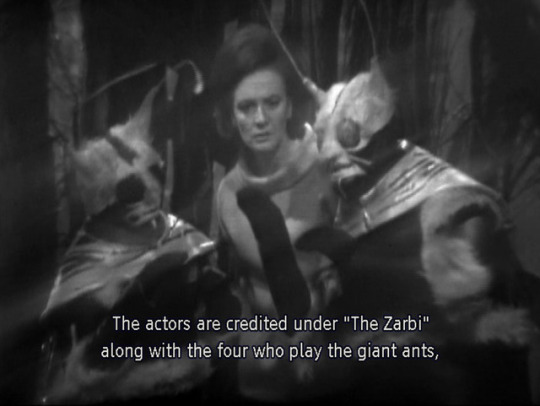



What are Larvi Guns? The world may never know.
Picture: Barbara and her butterflies, coming up with a plan. Infotext: Because the Larvi Guns were not Bill Strutton’s creation, nobody really knew what they were. The actors are credited under “The Zarbi” along with the four who play the giant ants, and this supports the notion that they might be an earlier, larval stage of the same species. But when Bill Strutton novelised the serial a few months later, he made them a separate species which disarms venomous attackers by piercing and emptying their poison sac with its snout.
30 notes
·
View notes
Text

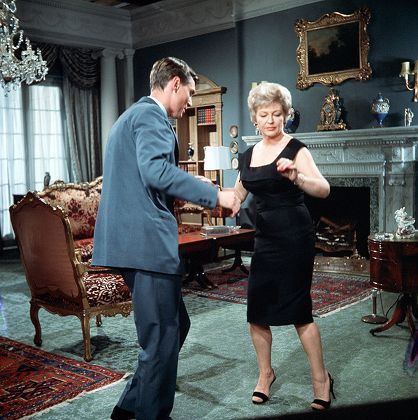
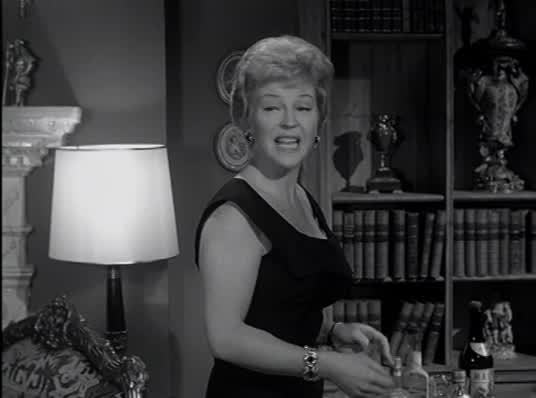
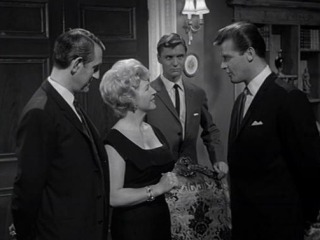
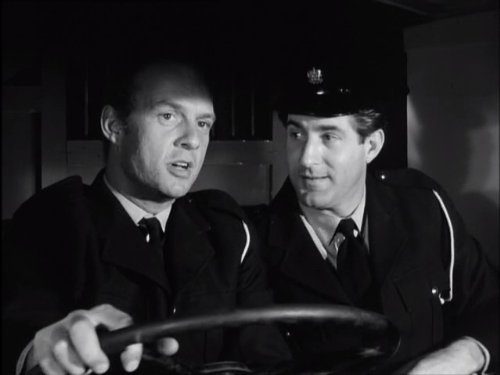

The Saint: The Rough Diamonds (2.10, ITC, 1963)
"They knew an awful lot about the movements of that van. In fact, it looks to me like an inside job."
"What do you think, Mr. Uttershaw?"
"I've no idea."
"Who knew about the shipment?"
"Well, our distributors, Ourley-Linnet; the airline company, the armoured security service... I think that's about all."
"And the insurers, of course."
"Oh yes, of course."
"And you."
"Inspector, I may have been on the plane but I can assure you I had absolutely nothing to do with this."
"A state of affairs which will continue indefinitely - I hope."
#the saint#the rough diamonds#itc#1963#leslie charteris#bill strutton#peter yates#roger moore#douglas wilmer#ivor dean#george a. cooper#vanda godsell#paul stassino#jemma hyde#michael meacham#william dexter#ray austin#geoffrey palmer#frank jarvis#fredric abbott#a good‚ solid episode this‚ helped in no small part by a very witty script from Bill Strutton. having made a brief appearance in Iris a#few episodes back‚ Ivor Dean is back as Teal and really gets to shine here; he gets some wonderful zingers and putdowns of Simon‚ and Deans#sardonic‚ withering delivery makes it easy to understand why the production team settled on him for their permanent Teal. also the first#appearance of his peppermints (they even get referenced in dialogue!). elsewhere we have Douglas Wilmer‚ still a couple of years from#Sherlock Holmes‚ but already a well established face on tv and in film; Geoffrey Palmer has a brief turn as an unconvincingly cockney#armoured car driver and permafave Paul Stassino lends his handsome looks and velvet voice to the role of chief henchman (ok i might have a#thing for him). Jemma Hyde is quite lovely and gets a little more character work as the Saintly love interest of the week; she was the#daughter of actors Hazel Terry and Geoffrey Keen‚ and was about half way through her all too brief acting career at this point (she'd#retired by the end of the decade). Ray Austin's presence once again means the fight scenes are very rough and tumble#including Simon throwing a man (kind of accidentally?) to his death‚ an act that of course has zero repercussions
2 notes
·
View notes
Text
0 notes
Text
Doctor Who Season Two: The Web Planet (1965) - Richard Martin/Bill Strutton/Dennis Spooner/Verity Lambert/BBC
0 notes
Video
youtube
Drone users in the UK may have to take safety awareness tests under legislation planned by the government.Drones weighing more than 250g could also be banned from flying near airports, or above 400 ft, in a crackdown on unsafe flying.Police will also be given new powers to seize and ground drones which may have been used in criminal activity.The bill has been welcomed by the pilots' union, which has warned of near misses involving drones and aircraft.Balpa said there had been 81 incidents so far this year - up from 71 in 2016 and 29 in 2015.The union's general secretary, Brian Strutton, said: "These proposals are a step towards the safe integration of drones, but until the new rules are in place the threat of a serious collision remains."In July a drone flew directly over the wing of a large passenger jet as it came into land at London's Gatwick Airport, which a report said had put 130 lives at risk.The proposed bill - to be published in spring 2018 - would ensure that owners of drones weighing more than 250g would need to register and sit a test.Drone pilot and trainer Elliott Corke, director of HexCam, said most recreationally and commercially-used drones in use weighed more than 250g, apart from the cheap toy versions.He told BBC News that many new users were surprised by how many rules around drone usage already exist, under the Civil Aviation Authority's Drone Code.He said there was a "degree of frustration" however that the rules were not being enforced effectively, allowing criminal activity to take place.Serena Kennedy, Assistant Chief Constable of the National Police Chiefs Council (NPCC), told BBC Breakfast: "At the moment we're using other bits of legislation - the Civil Aviation Authority's - to enable us to take action."This draft legislation will give us the powers we need to tackle drones when they are being used for criminal purposes."She said it would help police tackle the "increasing problem" of drones delivering items, such as drugs and mobile phones, to prisons.She said the legislation could allow police to look at how they can protect prison establishments from criminal drone activity through geo-fencing, which programmes no-fly zones into drones using GPS co-ordinates.Christian Struwe, head of European public policy at drone maker DJI, warned that some of the proposals may be "difficult to police" - for example the height restriction.But he told BBC Breakfast: "The good thing is that as an industry we are already working on it. We can limit how high they can fly."Mr Struwe pointed out that there was no "hard limit" on how close drones could fly to airports. "The current wording is that you should stay well clear," he said.He welcomed the proposals to limit the "bad use" of drones, adding that it was important people were aware there was regulation they needed to follow.Mr Corke agreed that there was a "lack of awareness" of the Drone Code, and said he was frustrated by the lack of focus on practical training."Most people don't read the manual or learn the safety features before they use their drones", he said, adding that many did not know what to do if something malfunctioned.Alongside the new laws, the government is also keen to develop technology allowing the greater use of drones for tasks including deliveries of everything from shopping to human organs.The transport minster, Lady Sugg, said the government wanted to strike the right balance between harnessing drone potential and ensuring they are not misused."We're bringing forward this legislation in order to ensure that drones can be used safely, whilst also addressing some of the safety and privacy concerns that people have," she said.The government is also working with drone manufacturers on technology which produces virtual barriers, to stop the machines operating in restricted areas.. by breaking news today
0 notes
Text
Doctor Who And The Zarbi by Bill Strutton (book review)
Doctor Who And The Zarbi by Bill Strutton (book review)
‘Doctor Who And The Zarbi’ is not a story I am familiar with and I feel sure if I’d seen this as a child it would have haunted me forever. The Doctor and his companions, Ian, Barbara and Vicki, are trapped when the TARDIS is compelled to land on a planet by a mysterious noise and force they cannot counteract. As the TARDIS, cannot move the Doctor and Ian decide to scout out the territory and the…
View On WordPress
0 notes